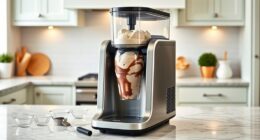Choosing between an ice cream maker and a KitchenAid attachment depends on your priorities. If you want authentic textures like gelato or soft serve and more control over the process, a dedicated ice cream maker is the best choice. However, if you prefer convenience, space-saving options, and already own a stand mixer, the KitchenAid attachment works well. Continue exploring to see which option suits your taste and lifestyle better.
Key Takeaways
- Dedicated ice cream makers excel at producing authentic textures like gelato and soft serve with precise control.
- Electric standalone models offer quicker, hands-free ice cream making with minimal effort.
- KitchenAid attachments are space-saving and versatile but rely on pre-frozen bowls and longer preparation times.
- Manual ice cream makers provide a hands-on experience but require more labor and time.
- The best choice depends on desired texture, convenience, existing equipment, and batch size preference.

When you’re deciding between an ice cream maker and a KitchenAid attachment, understanding their differences can help you make the right choice for your needs. Both options let you create delicious frozen treats at home, but they serve different purposes and come with unique features. A key factor to weigh if you’re evaluating is how they handle various textures, like gelato versus soft serve. Gelato tends to be denser, creamier, and served at slightly warmer temperatures, which many dedicated ice cream makers can produce effectively. Soft serve, on the other hand, is lighter, airier, and often requires a machine that can churn quickly and maintain a specific consistency. If you’re after authentic gelato, you might lean toward a manual or electric ice cream maker designed for slow churning and precise temperature control. For soft serve, a machine that can churn rapidly and incorporate air consistently is preferable.
Manual ice cream makers usually involve hand-cranking, which can be a fun but labor-intensive process. They tend to be more affordable and don’t require electricity, making them great if you enjoy a bit of hands-on involvement. Electric ice cream makers, however, do the work for you—simply add your ingredients, turn on the machine, and wait for the ice cream to churn. They often come with features like timers, built-in compressors, or pre-freezing bowls, giving you more control and convenience. If you want quick results and less effort, electric models are generally the way to go.
Manual ice cream makers involve hand-cranking for a hands-on experience, while electric models offer quick, effortless churning.
Now, when comparing these standalone ice cream makers to a KitchenAid attachment, consider how each fits into your lifestyle. The KitchenAid attachment is a more versatile, space-saving option. It attaches directly to your stand mixer and uses the mixer’s motor to churn your mixture. This means you don’t need a separate appliance, and you can make smaller batches as needed. However, unlike dedicated ice cream makers with built-in cooling, the KitchenAid attachment relies on pre-frozen bowls and takes longer to produce ice cream. It’s best if you already own a KitchenAid mixer and are willing to plan ahead. Additionally, understanding the technical differences between machines can help you choose the right tool for your preferred textures and batch sizes.
In the end, the choice depends on what’s more important to you: the authentic texture and control of a dedicated ice cream maker, or the convenience and multi-functionality of a KitchenAid attachment. If you’re passionate about perfecting gelato versus soft serve, go for an electric machine tailored to those textures. But if you want a multipurpose kitchen tool that can handle ice cream now and then, the attachment could be enough. Either way, you’ll be able to enjoy homemade frozen treats tailored to your taste.
Frequently Asked Questions
Which Option Is More Cost-Effective Long-Term?
When considering which option is more cost-effective long-term, you should focus on the cost comparison and durability analysis. A standalone ice cream maker may have a lower initial price but might require more maintenance or replacement parts over time. In contrast, a Kitchenaid attachment, though pricier upfront, tends to be more durable and versatile, often making it the more economical choice for long-term use.
Can Both Appliances Make Dairy-Free Ice Cream?
Think of your appliance as a blank canvas for creativity. Both your ice cream maker and Kitchenaid attachment can craft dairy-free ice cream using vegan options and dairy alternatives. You simply need to choose the right ingredients and follow suitable recipes. With a little effort, you can enjoy delicious, dairy-free frozen treats, regardless of which device you use, making your dessert options as endless as your imagination.
How Much Storage Space Is Required for Each?
You’ll want to contemplate storage capacity and countertop footprint for each appliance. An ice cream maker usually needs a dedicated space in your freezer and might be bulkier on your countertop, while a KitchenAid attachment is compact and stores easily in a cabinet when not in use. Think about how much space you have and how often you’ll use it to decide which suits your kitchen best.
Are There Differences in Ice Cream Texture Quality?
Think of your ice cream as a symphony—each note, or texture, matters. When you choose between options, you’ll notice texture variation can be smoother or creamier with a dedicated ice cream maker, offering more consistent quality. The Kitchenaid attachment provides ingredient flexibility, but may produce slightly less uniform textures. Your choice depends on whether you prioritize perfect texture or versatility in ingredients.
Which Appliance Is Better for Large Batches?
When choosing an appliance for large batches, consider your needs carefully. If you want to make big batches quickly, a dedicated ice cream maker typically offers a larger batch size and faster freezing times. However, if you prefer appliance portability and already own a stand mixer, the Kitchenaid attachment allows you to make sizable batches without extra equipment. Your choice depends on batch size preferences and convenience.
Conclusion
When it comes to choosing between an ice cream maker and a KitchenAid attachment, it really depends on your needs. If you make ice cream frequently, a dedicated machine might be worth it, especially since 60% of home cooks prefer machines for better texture. But if you want versatility and space-saving options, the attachment is a smart choice. Either way, you’ll be enjoying homemade ice cream in no time—happy scooping!











